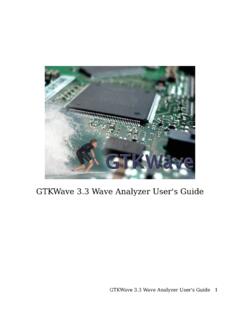Transcription of UltraScale FPGAs Transceivers Wizard v1 - Xilinx
1 UltraScale FPGAs Transceivers Wizard LogiCORE IP Product Guide Vivado Design Suite PG182 ( ) December 4, 2020. Table of Contents IP Facts Chapter 1: Overview Feature Summary.. 5. Applications .. 6. Licensing and Ordering Information .. 6. Chapter 2: Product Specification Wizard Basic Concepts.. 7. Performance.. 10. Resource Utilization.. 11. Port Descriptions .. 12. Chapter 3: Designing with the Core General Design Guidelines .. 59. Reset Controller Helper Block .. 60. Transmitter User Clocking Network Helper Block .. 68. Receiver User Clocking Network Helper Block .. 70. User Data Width Sizing Helper Block .. 73. Transmitter Buffer Bypass Controller Helper Block.. 74. Receiver Buffer Bypass Controller Helper Block .. 76. Transceiver Common Primitive.. 77. Chapter 4: Design Flow Steps Customizing and Generating the Core .. 80. Constraining the Core .. 97. Simulation .. 102. Synthesis and Implementation .. 102.
2 Chapter 5: Example Design Purpose of the Example Design .. 103. Hierarchy and Structure .. 104. Link Status and Initialization .. 107. UltraScale FPGAs Transceivers Wizard Send Feedback 2. PG182 ( ) December 4, 2020 VIO Core Instance.. 110. In-System IBERT Core Instance .. 112. Convenience Features .. 113. Adapting the Example Design .. 115. Limitations of the Example Design .. 116. Chapter 6: Test Bench Simulating the Example Design.. 117. Simulation Behavior.. 118. Appendix A: Migrating and Upgrading Migrating to the Vivado Design Suite.. 120. Upgrading from a Previous Version .. 120. Migrating from a Previous Device Family.. 121. Appendix B: Debugging Finding Help on .. 122. Vivado Design Suite Debug Feature .. 123. Appendix C: Additional Resources and Legal Notices Xilinx Resources .. 124. References .. 124. Revision History .. 125. Please Read: Important Legal Notices .. 129. UltraScale FPGAs Transceivers Wizard Send Feedback 3.
3 PG182 ( ) December 4, 2020 IP Facts Introduction LogiCORE IP Facts Table Core Specifics The UltraScale FPGAs Transceivers Wizard IP UltraScale + Families Supported core helps configure one or more serial Kintex UltraScale FPGA. Device Family (1). Transceivers . You can target an industry Virtex UltraScale FPGA. standard using provided configuration presets, Supported User Not Applicable Interfaces or start from scratch. The flexible Transceivers Resources See Table 2-2. Wizard generates a customized IP core for the Transceivers , configuration options, and Provided with Core enabled ports you have selected, optionally Design Files RTL. including a variety of helper blocks to simplify Example Design verilog common functionality. In addition, the Wizard Test Bench verilog can produce an example design for simple Constraints File Xilinx Design Constraints (XDC). simulation and hardware usage demonstration. Simulation Source HDL with SecureIP transceiver simulation Model models Supported Not Provided Features S/W Driver Tested Design Flows Transceiver configuration presets for Design Entry Vivado Design Suite industry standards Simulation For supported simulators , see the Xilinx Design Tools: Release Notes Guide.
4 Simple and intuitive feature selection flow Synthesis Vivado Synthesis Automatically sets transceiver parameters Support Release Notes Advanced options to tune performance and Known Master Answer Record: 57487. Issues Transceiver site and reference clock All Vivado IP. selection interface Change Logs Master Vivado IP Change Logs: 72775. Available helper blocks to simplify common Xilinx Support web page or complex transceiver usage Notes: 1. For a complete list of supported devices, see the Vivado IP. Optional exposure of any transceiver port catalog. depending upon the selected configuration Example design with configurable PRBS. generator, checker, and link status indicator to demonstrate functionality in simulation and hardware Flexible placement of each helper block: within core for simplicity, or within example design for user customization Support for UltraScale and UltraScale + . architectures UltraScale FPGAs Transceivers Wizard Send Feedback 4.
5 PG182 ( ) December 4, 2020 Product Specification Chapter 1. Overview The UltraScale FPGAs Transceivers Wizard is used to configure and simplify the use of one or more serial Transceivers in a Xilinx UltraScale or UltraScale + device. See Chapter 2, Product Specification for a detailed description of the core. This document describes the Wizard IP core. See the UltraScale Architecture GTH. Transceivers User Guide (UG576) [Ref 1] or UltraScale Architecture GTY Transceivers User Guide (UG578) [Ref 2] for details on the specific use and behavior of the serial Transceivers . Feature Summary The Wizard provides the following features: Customization flow driven by the Vivado Integrated Design Environment (IDE), providing high-level choices that configure supported transceiver features and automatically set primitive parameters, as appropriate Variety of transceiver configuration preset selections to target industry standards Advanced configuration options to tune transceiver performance Transceiver site, reference clock, and recovered clock selection interface for enabling one or more transceiver channels and adherence to clock routing restrictions Optional feature configuration interface for comma detection and alignment, channel bonding, clock correction, buffer control, advanced clocking, and some protocol-specific features Available helper blocks to simplify common or complex transceiver usage.
6 And the choice to either include or exclude each helper block from the core Helper blocks excluded from the core are delivered as user-customizable starting points within the example design Ability to locate enabled transceiver common primitives either within the core or in the example design, and connectivity to simplify resource sharing across multiple cores Optional port enablement interface provides the ability to expose any transceiver primitive port as a top-level core port. However, these ports should not be in conflict with any dependent helper core location and configuration of the Wizard . UltraScale FPGAs Transceivers Wizard Send Feedback 5. PG182 ( ) December 4, 2020 Chapter 1: Overview Synthesizable example design with configurable pseudo-random binary sequence (PRBS) data generator, checker, and link status indicator logic to quickly demonstrate core and transceiver functionality in simulation and hardware.
7 Simulation test bench that monitors example design PRBS lock in loopback, and indicates resulting link status Virtual input/output (VIO) core instance that simplifies basic example design hardware bring-up, and key debug signal probing Additional convenience features, including differential reference clock buffer instantiation and wiring, and per-channel vector slicing Core and example design level Xilinx design constraints (XDC) files with timing, location, and other constraints as necessary for the selected configuration Applications The Wizard is the supported method of configuring and using one or more serial Transceivers in a Xilinx UltraScale FPGA. Licensing and Ordering Information This Xilinx LogiCORE IP module is provided at no additional cost with the Xilinx Vivado Design Suite under the terms of the Xilinx End User License. Information about this and other Xilinx LogiCORE IP modules is available at the Xilinx Intellectual Property page.
8 For information about pricing and availability of other Xilinx LogiCORE IP modules and tools, contact your local Xilinx sales representative. UltraScale FPGAs Transceivers Wizard Send Feedback 6. PG182 ( ) December 4, 2020 Chapter 2. Product Specification The UltraScale FPGAs Transceivers Wizard core is the supported method of configuring and using one or more serial Transceivers in a Xilinx UltraScale or UltraScale + device. In addition to automatically setting primitive parameters as appropriate for your application, the Wizard simplifies serial transceiver usage by providing a variety of port enablement and helper block convenience functions. These concepts, as well as technical specifications, are described in this chapter. Wizard Basic Concepts Transceiver primitives. Fundamentally, the Wizard instantiates, configures, and connects one or more serial transceiver primitives to provide a simplified user interface to those resources.
9 The core instance configures the channel and common primitives by applying HDL parameter values derived from the Vivado Integrated Design Environment (IDE)-driven customization of that instance. Transceiver configuration presets. During Vivado IDE-driven customization, you can choose from a variety of transceiver configuration presets to target an industry standard. If required, customization settings can be further modified to suit your application. Optional port enablement. Xilinx serial transceiver primitives have many ports, and most ports are usually not required for any one use mode. The Wizard provides access to all transceiver primitive ports using an optional port enablement interface, but by default offers a compact user interface by exposing only those ports likely to be necessary for the core as customized. Some of the ports might not be applicable to be exposed from GT. Wizard core due to the customization and optional enablement of some of the helper cores.
10 Helper blocks. The Wizard provides optional modules called helper blocks that abstract or automate certain common or complex transceiver usage procedures. Each helper block can be located either within the core or outside it. They are delivered with the example design as a user-modifiable starting point. Helper blocks in this release include: Reset controller. Controls and abstracts the transceiver reset sequence. Transmitter user clocking network. Contains resources to drive the transmitter user clocking network. UltraScale FPGAs Transceivers Wizard Send Feedback 7. PG182 ( ) December 4, 2020 Chapter 2: Product Specification Receiver user clocking network. Contains resources to drive the receiver user clocking network. User data width sizing. Sizes the transmitter and receiver data vectors to the specified user widths. Transmitter buffer bypass controller. Controls and abstracts the transmitter buffer bypass procedure, if required.












